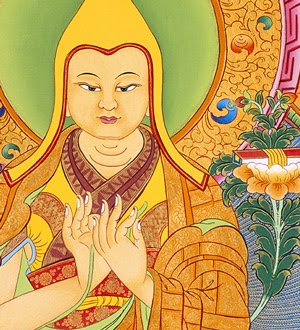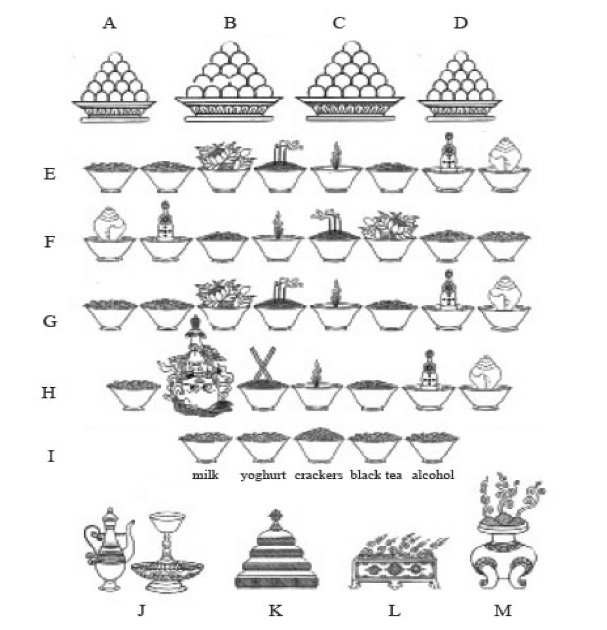Finding Peace and Solace
10 Apr
 For those of you who are interested in engaging in a Je Tsongkhapa retreat, I have taken the liberty to include here the instructions from the Tsongkhapa boxset manual. However, I would encourage those of you who are interested in conducting the retreat to go through the entire manual and read about Je Tsongkhapa's amazing life story, prayers and practice. You can invite the Tsongkhapa boxset from
For those of you who are interested in engaging in a Je Tsongkhapa retreat, I have taken the liberty to include here the instructions from the Tsongkhapa boxset manual. However, I would encourage those of you who are interested in conducting the retreat to go through the entire manual and read about Je Tsongkhapa's amazing life story, prayers and practice. You can invite the Tsongkhapa boxset from
http://www.vajrasecrets.com/tsongkhapa-boxset-english
If you can't afford the boxset or you have further questions, do let me know. Thank you ~
Tsongkhapa Retreat
We can engage in spiritual retreats of body (physical), speech (verbal) and mind (mental). A physical retreat is when we keep ourselves physically away from distractions while a verbal retreat is when we keep silence and avoid idle chatter. A mental retreat is when we restrain ourselves from negative emotions such as anger and attachments. In order to have a successful retreat, it is important to practise all three simultaneously, because even if we are having a physical and a verbal retreat but we do not control our minds and let our delusions influence us, our retreats will not be successful.
In a Migtsema retreat, we should aim to achieve 100,000 recitations of Migtsema. However, it is also possible to break it down to several small retreats. You can do a weekend retreat and achieve 5,000 recitations, for example.
It is excellent to do retreats for your birthday or for birthdays of loved ones. Then, you can dedicate the merit of the retreat to your loved ones – for their long life, health, success and happiness. You can do retreats on your own, with your Dharma community or even with family and friends.
Preparations for a Retreat
Decide on where your retreat area will be. It can be a room in your house, or if space is limited, you can designate an area in your room for the retreat. Make sure it is clean and that there is space for an altar and a place to sit.
Seat
 In front of the altar, choose a spot where you will sit throughout the retreat. On that spot, place a picture of a swastika, which represents indestructibility. Swastika comes from the Sanskrit word svasti, which means well being or good fortune. Recite Migstema and blow on the image of the swastika. Then, take two stalks of kusha grass[1] and place it on top of the swastika. A longer stalk should be placed facing outwards, vertically; a shorter stalk is then placed across, perpendicular to the longer stalk, like a cross.
In front of the altar, choose a spot where you will sit throughout the retreat. On that spot, place a picture of a swastika, which represents indestructibility. Swastika comes from the Sanskrit word svasti, which means well being or good fortune. Recite Migstema and blow on the image of the swastika. Then, take two stalks of kusha grass[1] and place it on top of the swastika. A longer stalk should be placed facing outwards, vertically; a shorter stalk is then placed across, perpendicular to the longer stalk, like a cross.
Place your meditational cushion on top of both the swastika and the kusha grass. This is where you will sit throughout the retreat and it should not be moved until the completion of the retreat. Be careful that other people do not sit or step on this seat throughout the duration of your retreat.
Altar
As this is a Tsongkhapa retreat, there should be a statue or thangka of Lama Tsongkhapa as the main focus of the altar. In front, there should be a picture of your Guru and on the side, a picture or tsa tsa of your Dharma Protector, such as Lord Setrap.
Tormas
In front of the images, there should be four tormas set up. The torma offerings symbolise generosity and the sizes of the tormas are up to us. There should be (1) a large torma for Tsongkhapa (2) a smaller torma for Tsongkhapa’s entourage (3) a large torma for Dharmapala Setrap and (4) a smaller torma for Setrap’s entourage.
The tormas can be made out of cakes, biscuits or chocolates. In tropical countries like Malaysia, it would be more practical to put the torma offerings into sealed jars to prevent an insect infestation. The tormas can be changed daily or weekly, it is up to you. After the retreat, the tormas can be eaten or offered to birds to eat.
Offerings
There should be two sets of offerings to Lama Tsongkhapa. Immediately, in front of the tormas, from your left to right (you are facing the altar), make the outer offerings to Lama Tsongkhapa with: water to drink, water for the feet, flowers, incense, light, perfume, food and sound.
Next, make the inner, or self-generated, offerings to Lama Tsongkhapa, where the offerings are placed in reverse order. From your left to right, offer food, perfume, light, incense, flowers, water for the feet and water to drink respectively.
Also offer two sets of offerings to your Dharma Protector, in this case, Lord Setrap. First, the peaceful offerings and secondly, the wrathful offerings, following the guidelines in the diagram. The size of the offerings are up to you.
Next is the optional set of five commitment offerings: black tea, alcohol, tsampa (flour or oats), yoghurt and milk.
Finally, there should be a serkym offering, the golden drink offering to the Dharma Protector. This can be black tea, milk or yoghurt.
Retreat Offerings for the Altar
A= Tsongkhapa’s entourage Torma
B= Tsongkhapa’s Torma
C= Setrap’s Torma
D= Setrap’s entourage Torma
E = Peaceful sensory (outer generation) offerings to Lama Tsongkhapa (Yidam): water, water, flowers, incense, light, perfume, food, sound.
F = Peaceful sensory (inner generation) offerings to ourselves: sound, food, perfume, light, incense, flowers, water, water.
G = Peaceful sensory offerings to Setrap: water, water, flowers, incense, light, perfume, food, sound.
H = Wrathful sensory offerings to Setrap: black tea (blood), wrathful flower (picture is permissible), Incense (crossed), light, perfume (bile), food (flesh), sound.
I = Commitment offerings: milk, yoghurt, crackers, black tea, alcohol (beer, wine etc)
J = Serkym set: black tea, alcohol or milk
K= Mandala Set
L= Incense
M= (optional) Protector incense (juniper if possible) to be offered throughout the invocation verses.
The prayers for the retreat should be recited in the order below. The visualisation and meditations are as I have already explained.
- Refuge
- Four Immeasurables
- Guru Yoga
- Migtsema with the seven types of visualisations.
- Torma offering
- Praise of Tsongkhapa
- Yonten Shigyurma
- Dissolution
- Disciples dissolve into Lama Tsongkhapa
- Tsongkhapa comes to you
- Tsongkhapa dissolves into you
- Powa
- Concentrate on your consciousness so you are ready to leave to go to Gaden Paradise
10. Invocation to Setrap
11. Praise to Setrap
12. Serkym offering
13. Enthronement
14. Completion Dedication
15. Yonten Shigyurma
[1] Kusha grass is scientifically known as Desmostachya bipinnata. In the USA, it is called Big cordgrass or Salt reed-grass, and in Australia, it is known as Halfa grass.






Hi david,
Thanks for sharing this 🙂
Hey Jim,
You’re welcome. Do share if you plan to engage in Tsongkhapa retreat…
Dear David,
Thanks so much for sharing this, I love Lama Tsongkhapa
and will bookmark this page as it has detailed instructions,
i always have trouble remembering the direction
of the swastika~so this is very helpful, thank you again,
Yours In Dharma,
Oya
http://www.cdbaby.com/cd/yokomusic
Dear Oya,
I am glad what I posted here helped you very much. If you can, do try to purchase the Tsongkhapa boxset. It has a lot of information that you will appreciate and it will help your practice as well. Thank you.
David